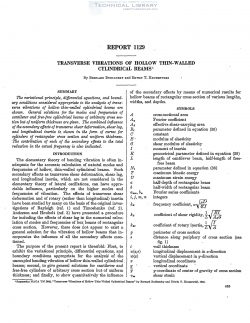naca-report-1129
- Version
- 159 Downloads
- 975.82 KB File Size
- 1 File Count
- October 28, 2016 Create Date
- October 28, 2016 Last Updated
National Advisory Committee for Aeronautics, Report - Transverse Vibrations of Hollow Thin Walled Cylindrical Beams

The variational principle, diferential equations, and bound—
ary conditions considered appropriate to the analysis of trans-
verse vibrations of hollow thinnealled cylindrical beams are
shown. General solutions for the modes and frequencies of
cantilever and free-free cylindrical beams of arbitrary cross sec-
tion but of uniform thickness are given. The combined influence
of the secondary ejects of transverse shear deformation, shear lag,
and longitudinal inertia is, shown in the form of curves for
cylinders of rectangular cross section and uniform thickness.
The contribution of each of the secondary efects to the total
reduction in the actual frequency is also indicated.
The elementary theory of bending vibration is often in—
adequate for the accurate calculation of natural modes and
frequencies of hollow, thin—walled cylindrical beams. Such
secondary effects as transverse shear deformation, shear lag,
and longitudinal inertia, which are not considered in the
elementary theory of lateral oscillations, can have appre-
ciable influence, particularly on the higher modes and
frequencies of vibration. The effects of transverse shear
deformation and of rotary (rather than longitudinal) inertia
have been studied by many on the basis of the original inves-
tigations of Rayleigh (ref. 1) and Timoshenko (ref. 2).
Anderson and Houbolt (ref. 3) have presented a procedure
for including the effects of shear lag in the numerical calcu-
lation of modes and frequencies of box beams of rectangular
cross section. However, there does not appear to exist a
general solution for the vibration of hollow beams that m-
corporates the influence of all the secondary effects men-
tioned.
| File | Action |
|---|---|
| naca-report-1129 Transverse Vibrations of Hollow Thin Walled Cylindrical Beams.pdf | Download |

Comment On This Post